Report on Wi-Fi Architecture in Wireless Networks (MITS)
VerifiedAdded on 2023/03/23
|7
|1283
|51
Report
AI Summary
This report provides an in-depth analysis of Wi-Fi architecture, comparing two research papers: "WiFi Direct and LTE D2D in Action" and "An overview of Technical aspect for Wi-Fi Networks Technology." The report examines the methodologies used, including qualitative and mixed research designs, and secondary data collection. It compares the findings of both papers, highlighting the importance of Wi-Fi technology and device-to-device communication. The report discusses the advantages and disadvantages of each paper, suggesting improvements such as literature reviews and applications of Wi-Fi technology. The conclusion emphasizes Wi-Fi's effectiveness in communication and data transfer.
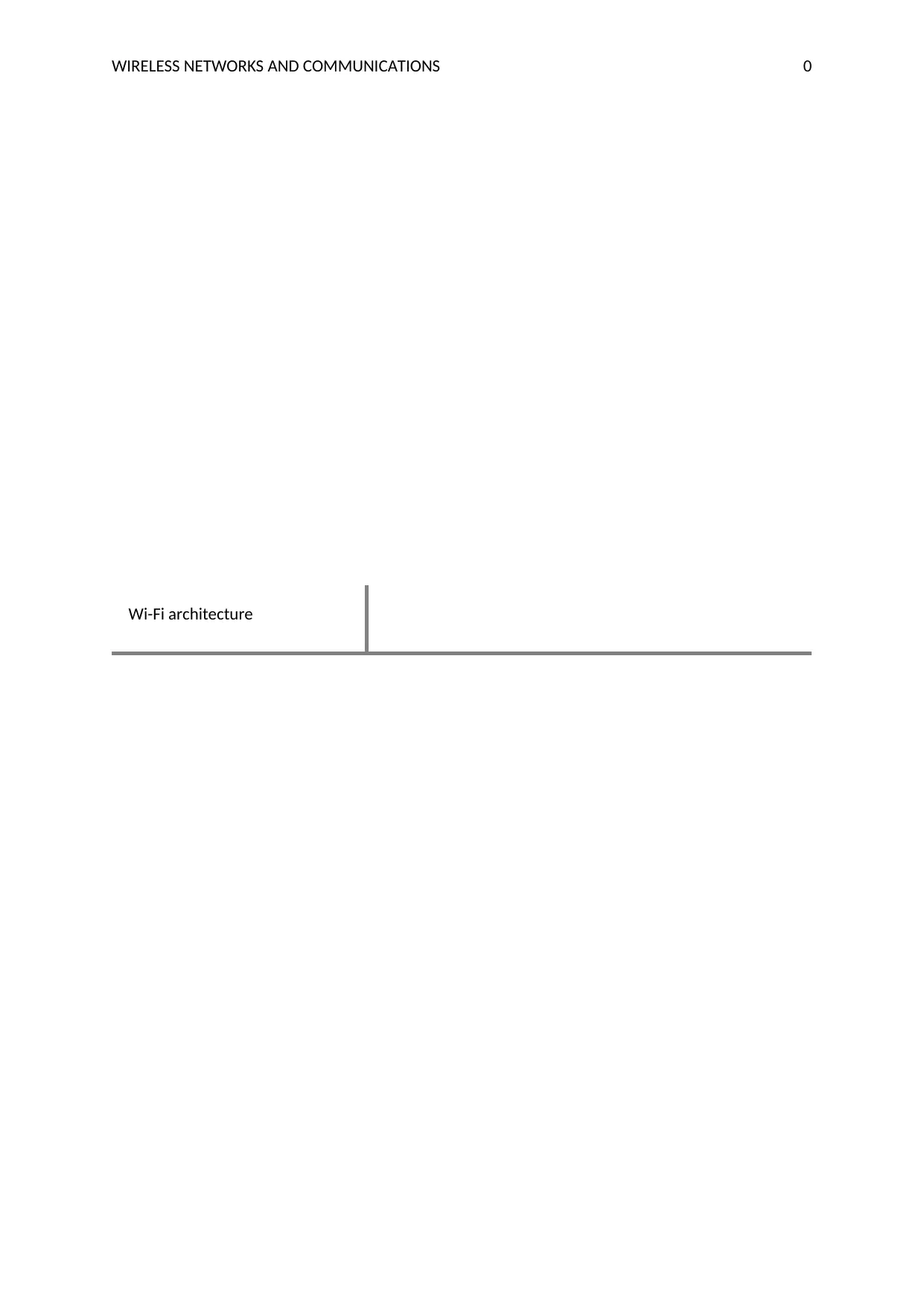
WIRELESS NETWORKS AND COMMUNICATIONS 0
Wi-Fi architecture
Wi-Fi architecture
Paraphrase This Document
Need a fresh take? Get an instant paraphrase of this document with our AI Paraphraser
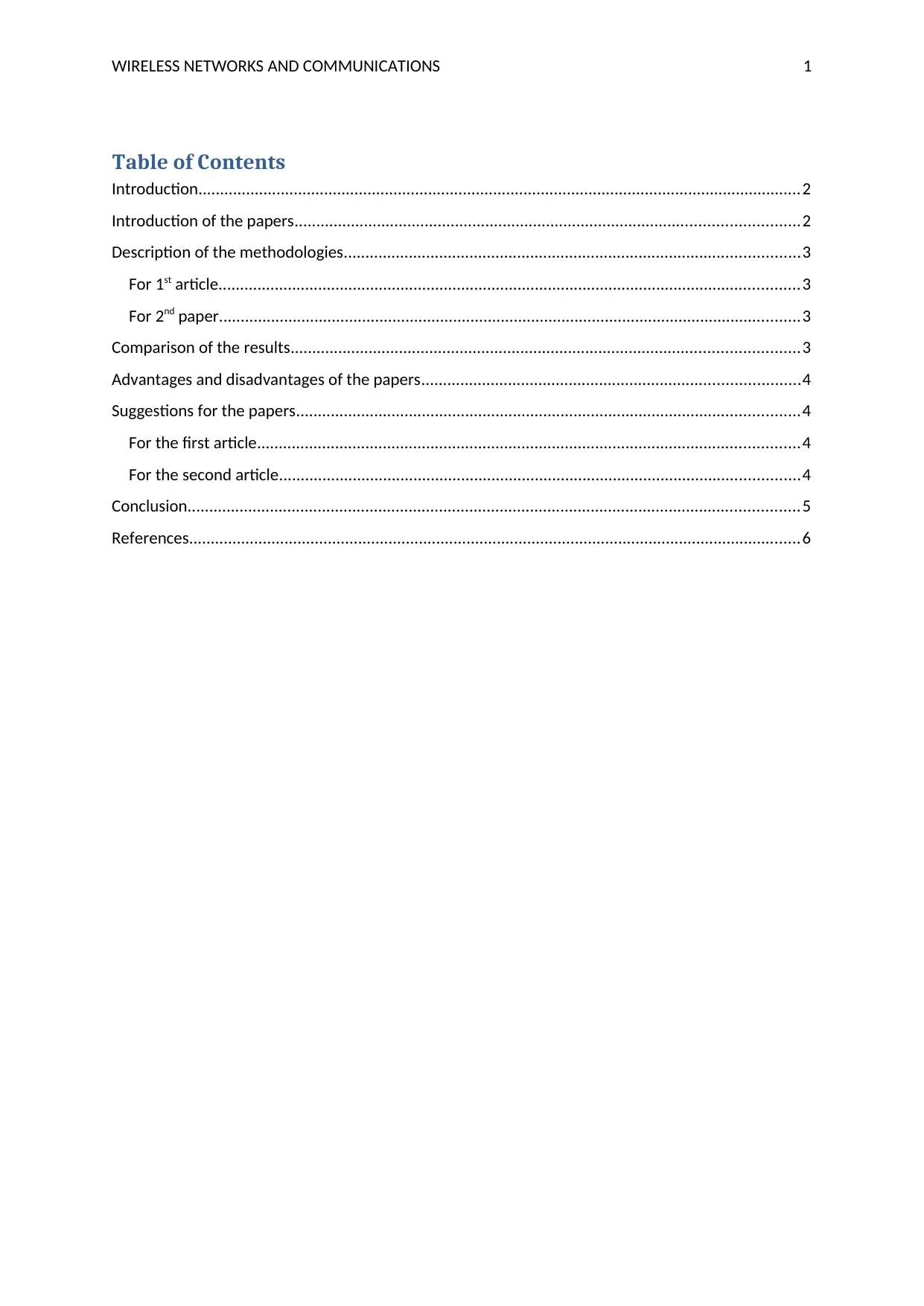
WIRELESS NETWORKS AND COMMUNICATIONS 1
Table of Contents
Introduction...........................................................................................................................................2
Introduction of the papers....................................................................................................................2
Description of the methodologies.........................................................................................................3
For 1st article......................................................................................................................................3
For 2nd paper......................................................................................................................................3
Comparison of the results.....................................................................................................................3
Advantages and disadvantages of the papers.......................................................................................4
Suggestions for the papers....................................................................................................................4
For the first article.............................................................................................................................4
For the second article........................................................................................................................4
Conclusion.............................................................................................................................................5
References.............................................................................................................................................6
Table of Contents
Introduction...........................................................................................................................................2
Introduction of the papers....................................................................................................................2
Description of the methodologies.........................................................................................................3
For 1st article......................................................................................................................................3
For 2nd paper......................................................................................................................................3
Comparison of the results.....................................................................................................................3
Advantages and disadvantages of the papers.......................................................................................4
Suggestions for the papers....................................................................................................................4
For the first article.............................................................................................................................4
For the second article........................................................................................................................4
Conclusion.............................................................................................................................................5
References.............................................................................................................................................6
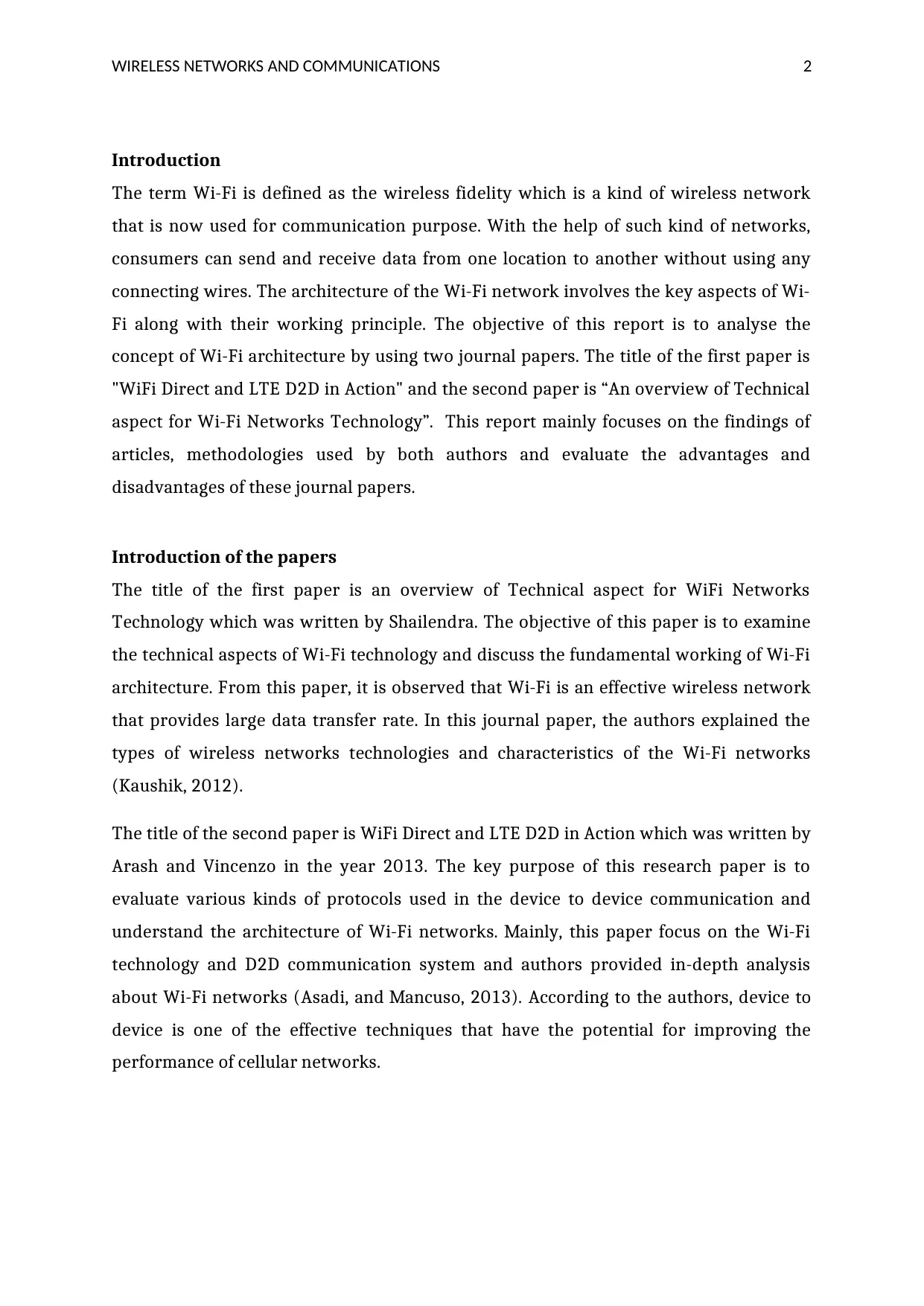
WIRELESS NETWORKS AND COMMUNICATIONS 2
Introduction
The term Wi-Fi is defined as the wireless fidelity which is a kind of wireless network
that is now used for communication purpose. With the help of such kind of networks,
consumers can send and receive data from one location to another without using any
connecting wires. The architecture of the Wi-Fi network involves the key aspects of Wi-
Fi along with their working principle. The objective of this report is to analyse the
concept of Wi-Fi architecture by using two journal papers. The title of the first paper is
"WiFi Direct and LTE D2D in Action" and the second paper is “An overview of Technical
aspect for Wi-Fi Networks Technology”. This report mainly focuses on the findings of
articles, methodologies used by both authors and evaluate the advantages and
disadvantages of these journal papers.
Introduction of the papers
The title of the first paper is an overview of Technical aspect for WiFi Networks
Technology which was written by Shailendra. The objective of this paper is to examine
the technical aspects of Wi-Fi technology and discuss the fundamental working of Wi-Fi
architecture. From this paper, it is observed that Wi-Fi is an effective wireless network
that provides large data transfer rate. In this journal paper, the authors explained the
types of wireless networks technologies and characteristics of the Wi-Fi networks
(Kaushik, 2012).
The title of the second paper is WiFi Direct and LTE D2D in Action which was written by
Arash and Vincenzo in the year 2013. The key purpose of this research paper is to
evaluate various kinds of protocols used in the device to device communication and
understand the architecture of Wi-Fi networks. Mainly, this paper focus on the Wi-Fi
technology and D2D communication system and authors provided in-depth analysis
about Wi-Fi networks (Asadi, and Mancuso, 2013). According to the authors, device to
device is one of the effective techniques that have the potential for improving the
performance of cellular networks.
Introduction
The term Wi-Fi is defined as the wireless fidelity which is a kind of wireless network
that is now used for communication purpose. With the help of such kind of networks,
consumers can send and receive data from one location to another without using any
connecting wires. The architecture of the Wi-Fi network involves the key aspects of Wi-
Fi along with their working principle. The objective of this report is to analyse the
concept of Wi-Fi architecture by using two journal papers. The title of the first paper is
"WiFi Direct and LTE D2D in Action" and the second paper is “An overview of Technical
aspect for Wi-Fi Networks Technology”. This report mainly focuses on the findings of
articles, methodologies used by both authors and evaluate the advantages and
disadvantages of these journal papers.
Introduction of the papers
The title of the first paper is an overview of Technical aspect for WiFi Networks
Technology which was written by Shailendra. The objective of this paper is to examine
the technical aspects of Wi-Fi technology and discuss the fundamental working of Wi-Fi
architecture. From this paper, it is observed that Wi-Fi is an effective wireless network
that provides large data transfer rate. In this journal paper, the authors explained the
types of wireless networks technologies and characteristics of the Wi-Fi networks
(Kaushik, 2012).
The title of the second paper is WiFi Direct and LTE D2D in Action which was written by
Arash and Vincenzo in the year 2013. The key purpose of this research paper is to
evaluate various kinds of protocols used in the device to device communication and
understand the architecture of Wi-Fi networks. Mainly, this paper focus on the Wi-Fi
technology and D2D communication system and authors provided in-depth analysis
about Wi-Fi networks (Asadi, and Mancuso, 2013). According to the authors, device to
device is one of the effective techniques that have the potential for improving the
performance of cellular networks.
⊘ This is a preview!⊘
Do you want full access?
Subscribe today to unlock all pages.

Trusted by 1+ million students worldwide
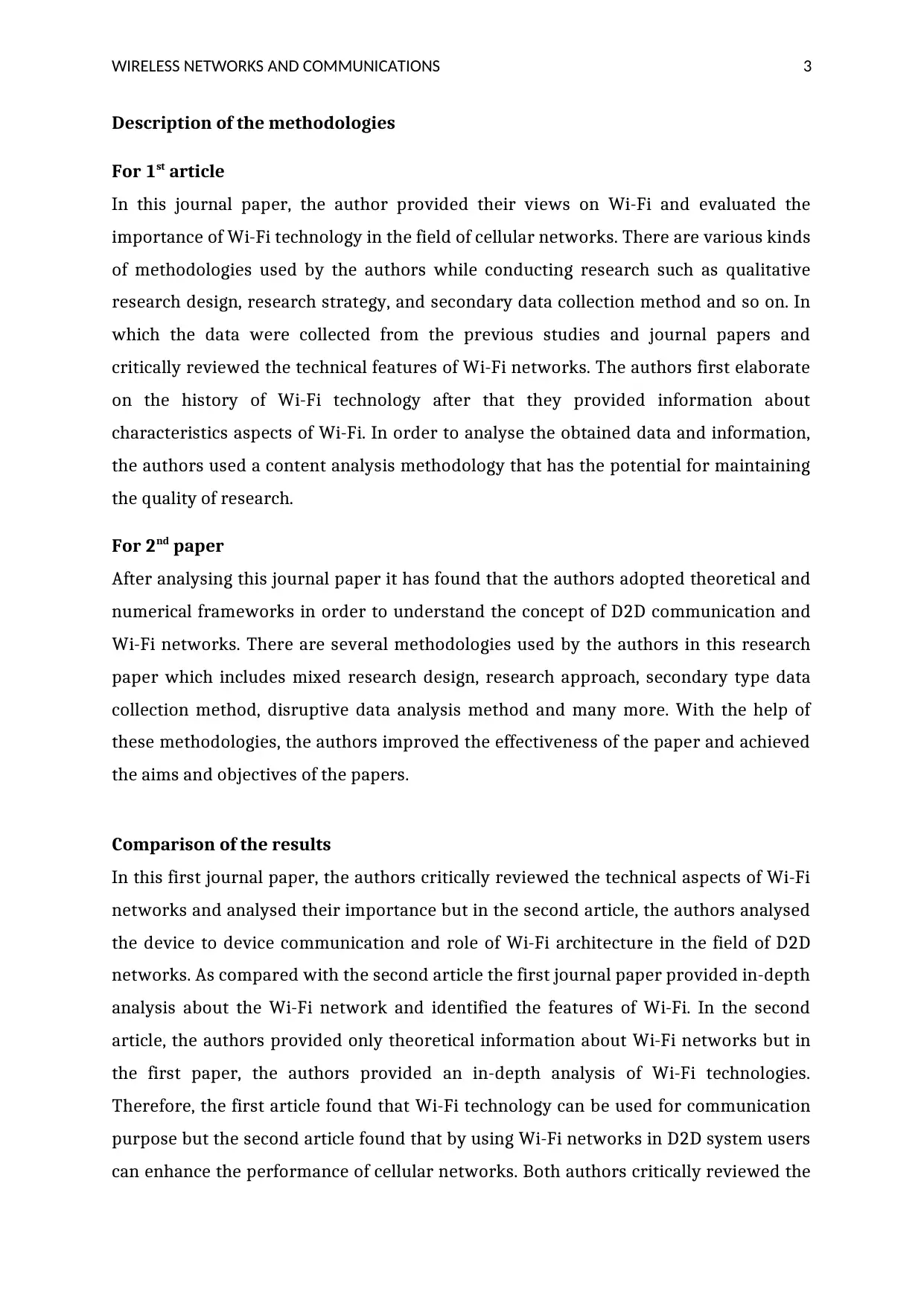
WIRELESS NETWORKS AND COMMUNICATIONS 3
Description of the methodologies
For 1st article
In this journal paper, the author provided their views on Wi-Fi and evaluated the
importance of Wi-Fi technology in the field of cellular networks. There are various kinds
of methodologies used by the authors while conducting research such as qualitative
research design, research strategy, and secondary data collection method and so on. In
which the data were collected from the previous studies and journal papers and
critically reviewed the technical features of Wi-Fi networks. The authors first elaborate
on the history of Wi-Fi technology after that they provided information about
characteristics aspects of Wi-Fi. In order to analyse the obtained data and information,
the authors used a content analysis methodology that has the potential for maintaining
the quality of research.
For 2nd paper
After analysing this journal paper it has found that the authors adopted theoretical and
numerical frameworks in order to understand the concept of D2D communication and
Wi-Fi networks. There are several methodologies used by the authors in this research
paper which includes mixed research design, research approach, secondary type data
collection method, disruptive data analysis method and many more. With the help of
these methodologies, the authors improved the effectiveness of the paper and achieved
the aims and objectives of the papers.
Comparison of the results
In this first journal paper, the authors critically reviewed the technical aspects of Wi-Fi
networks and analysed their importance but in the second article, the authors analysed
the device to device communication and role of Wi-Fi architecture in the field of D2D
networks. As compared with the second article the first journal paper provided in-depth
analysis about the Wi-Fi network and identified the features of Wi-Fi. In the second
article, the authors provided only theoretical information about Wi-Fi networks but in
the first paper, the authors provided an in-depth analysis of Wi-Fi technologies.
Therefore, the first article found that Wi-Fi technology can be used for communication
purpose but the second article found that by using Wi-Fi networks in D2D system users
can enhance the performance of cellular networks. Both authors critically reviewed the
Description of the methodologies
For 1st article
In this journal paper, the author provided their views on Wi-Fi and evaluated the
importance of Wi-Fi technology in the field of cellular networks. There are various kinds
of methodologies used by the authors while conducting research such as qualitative
research design, research strategy, and secondary data collection method and so on. In
which the data were collected from the previous studies and journal papers and
critically reviewed the technical features of Wi-Fi networks. The authors first elaborate
on the history of Wi-Fi technology after that they provided information about
characteristics aspects of Wi-Fi. In order to analyse the obtained data and information,
the authors used a content analysis methodology that has the potential for maintaining
the quality of research.
For 2nd paper
After analysing this journal paper it has found that the authors adopted theoretical and
numerical frameworks in order to understand the concept of D2D communication and
Wi-Fi networks. There are several methodologies used by the authors in this research
paper which includes mixed research design, research approach, secondary type data
collection method, disruptive data analysis method and many more. With the help of
these methodologies, the authors improved the effectiveness of the paper and achieved
the aims and objectives of the papers.
Comparison of the results
In this first journal paper, the authors critically reviewed the technical aspects of Wi-Fi
networks and analysed their importance but in the second article, the authors analysed
the device to device communication and role of Wi-Fi architecture in the field of D2D
networks. As compared with the second article the first journal paper provided in-depth
analysis about the Wi-Fi network and identified the features of Wi-Fi. In the second
article, the authors provided only theoretical information about Wi-Fi networks but in
the first paper, the authors provided an in-depth analysis of Wi-Fi technologies.
Therefore, the first article found that Wi-Fi technology can be used for communication
purpose but the second article found that by using Wi-Fi networks in D2D system users
can enhance the performance of cellular networks. Both authors critically reviewed the
Paraphrase This Document
Need a fresh take? Get an instant paraphrase of this document with our AI Paraphraser
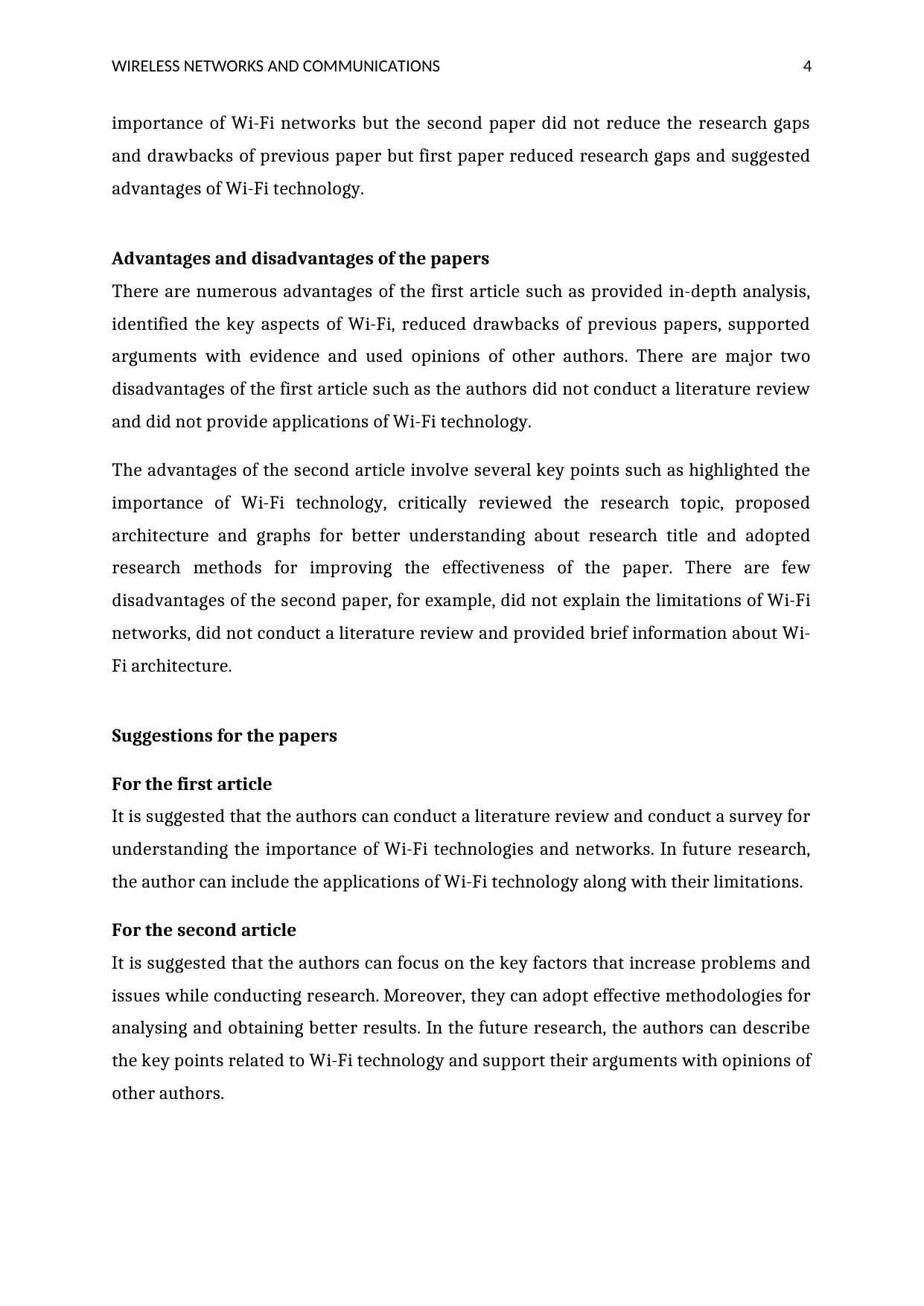
WIRELESS NETWORKS AND COMMUNICATIONS 4
importance of Wi-Fi networks but the second paper did not reduce the research gaps
and drawbacks of previous paper but first paper reduced research gaps and suggested
advantages of Wi-Fi technology.
Advantages and disadvantages of the papers
There are numerous advantages of the first article such as provided in-depth analysis,
identified the key aspects of Wi-Fi, reduced drawbacks of previous papers, supported
arguments with evidence and used opinions of other authors. There are major two
disadvantages of the first article such as the authors did not conduct a literature review
and did not provide applications of Wi-Fi technology.
The advantages of the second article involve several key points such as highlighted the
importance of Wi-Fi technology, critically reviewed the research topic, proposed
architecture and graphs for better understanding about research title and adopted
research methods for improving the effectiveness of the paper. There are few
disadvantages of the second paper, for example, did not explain the limitations of Wi-Fi
networks, did not conduct a literature review and provided brief information about Wi-
Fi architecture.
Suggestions for the papers
For the first article
It is suggested that the authors can conduct a literature review and conduct a survey for
understanding the importance of Wi-Fi technologies and networks. In future research,
the author can include the applications of Wi-Fi technology along with their limitations.
For the second article
It is suggested that the authors can focus on the key factors that increase problems and
issues while conducting research. Moreover, they can adopt effective methodologies for
analysing and obtaining better results. In the future research, the authors can describe
the key points related to Wi-Fi technology and support their arguments with opinions of
other authors.
importance of Wi-Fi networks but the second paper did not reduce the research gaps
and drawbacks of previous paper but first paper reduced research gaps and suggested
advantages of Wi-Fi technology.
Advantages and disadvantages of the papers
There are numerous advantages of the first article such as provided in-depth analysis,
identified the key aspects of Wi-Fi, reduced drawbacks of previous papers, supported
arguments with evidence and used opinions of other authors. There are major two
disadvantages of the first article such as the authors did not conduct a literature review
and did not provide applications of Wi-Fi technology.
The advantages of the second article involve several key points such as highlighted the
importance of Wi-Fi technology, critically reviewed the research topic, proposed
architecture and graphs for better understanding about research title and adopted
research methods for improving the effectiveness of the paper. There are few
disadvantages of the second paper, for example, did not explain the limitations of Wi-Fi
networks, did not conduct a literature review and provided brief information about Wi-
Fi architecture.
Suggestions for the papers
For the first article
It is suggested that the authors can conduct a literature review and conduct a survey for
understanding the importance of Wi-Fi technologies and networks. In future research,
the author can include the applications of Wi-Fi technology along with their limitations.
For the second article
It is suggested that the authors can focus on the key factors that increase problems and
issues while conducting research. Moreover, they can adopt effective methodologies for
analysing and obtaining better results. In the future research, the authors can describe
the key points related to Wi-Fi technology and support their arguments with opinions of
other authors.
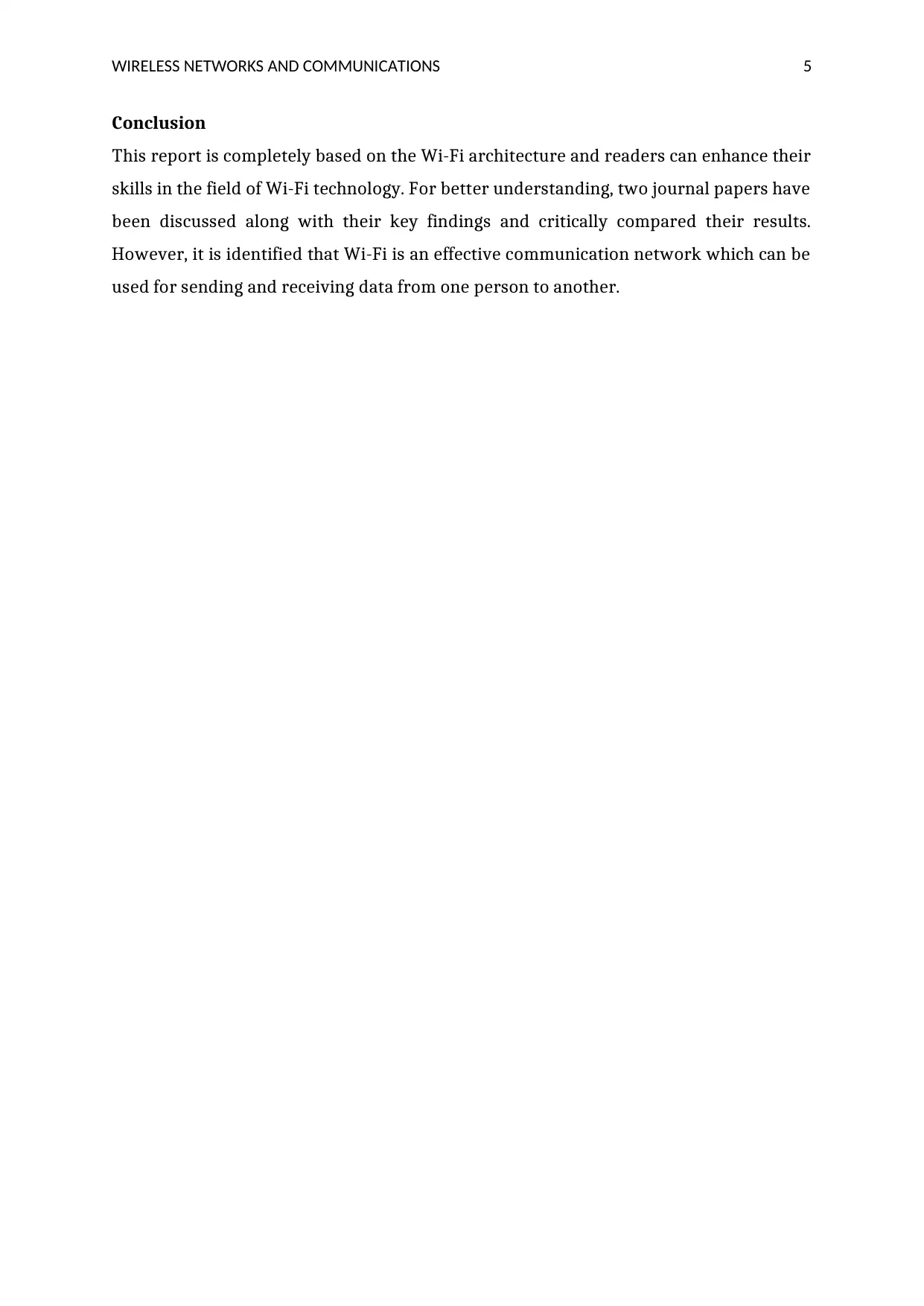
WIRELESS NETWORKS AND COMMUNICATIONS 5
Conclusion
This report is completely based on the Wi-Fi architecture and readers can enhance their
skills in the field of Wi-Fi technology. For better understanding, two journal papers have
been discussed along with their key findings and critically compared their results.
However, it is identified that Wi-Fi is an effective communication network which can be
used for sending and receiving data from one person to another.
Conclusion
This report is completely based on the Wi-Fi architecture and readers can enhance their
skills in the field of Wi-Fi technology. For better understanding, two journal papers have
been discussed along with their key findings and critically compared their results.
However, it is identified that Wi-Fi is an effective communication network which can be
used for sending and receiving data from one person to another.
⊘ This is a preview!⊘
Do you want full access?
Subscribe today to unlock all pages.

Trusted by 1+ million students worldwide
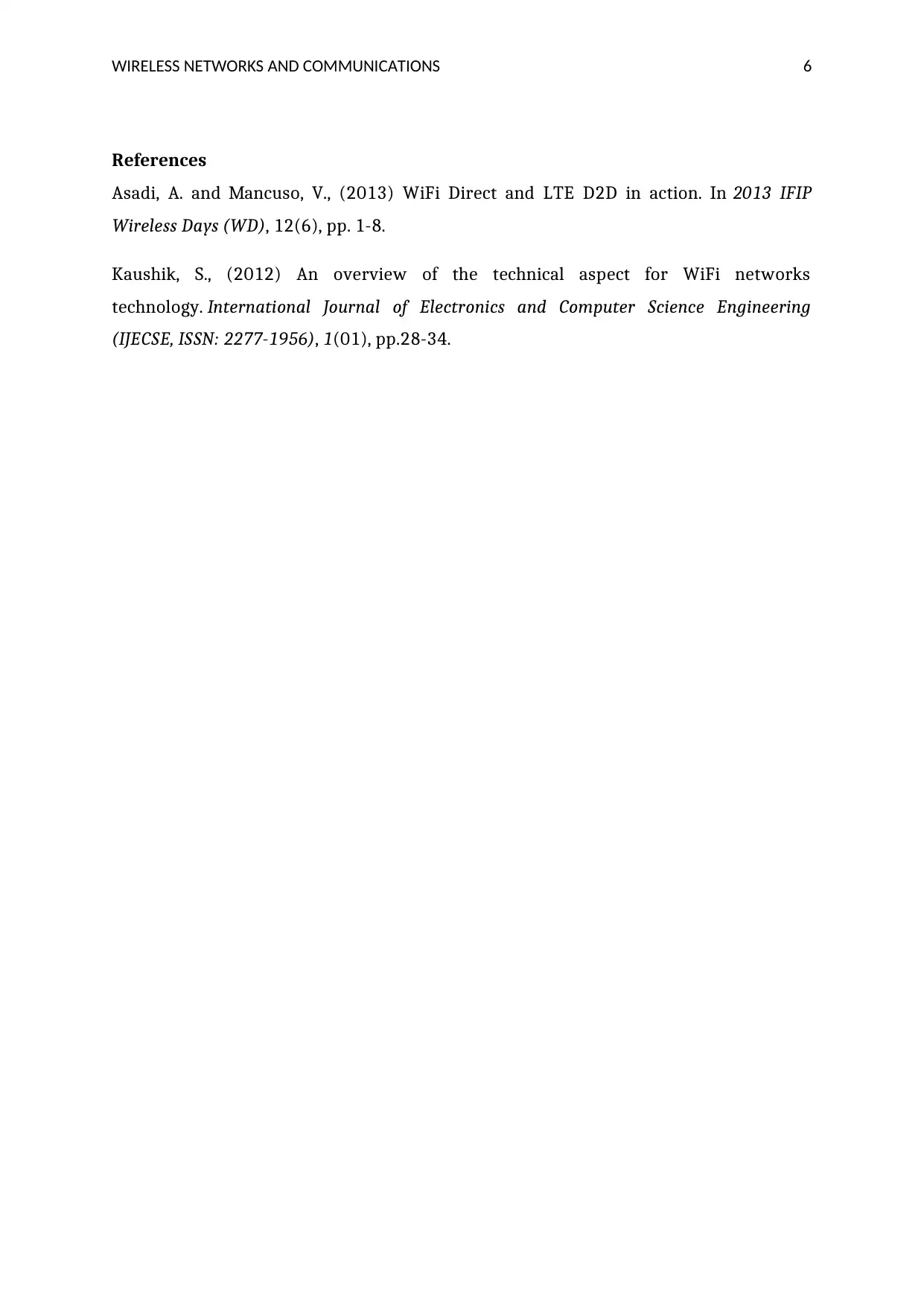
WIRELESS NETWORKS AND COMMUNICATIONS 6
References
Asadi, A. and Mancuso, V., (2013) WiFi Direct and LTE D2D in action. In 2013 IFIP
Wireless Days (WD), 12(6), pp. 1-8.
Kaushik, S., (2012) An overview of the technical aspect for WiFi networks
technology. International Journal of Electronics and Computer Science Engineering
(IJECSE, ISSN: 2277-1956), 1(01), pp.28-34.
References
Asadi, A. and Mancuso, V., (2013) WiFi Direct and LTE D2D in action. In 2013 IFIP
Wireless Days (WD), 12(6), pp. 1-8.
Kaushik, S., (2012) An overview of the technical aspect for WiFi networks
technology. International Journal of Electronics and Computer Science Engineering
(IJECSE, ISSN: 2277-1956), 1(01), pp.28-34.
1 out of 7
Related Documents
Your All-in-One AI-Powered Toolkit for Academic Success.
+13062052269
info@desklib.com
Available 24*7 on WhatsApp / Email
![[object Object]](/_next/static/media/star-bottom.7253800d.svg)
Unlock your academic potential
Copyright © 2020–2025 A2Z Services. All Rights Reserved. Developed and managed by ZUCOL.

